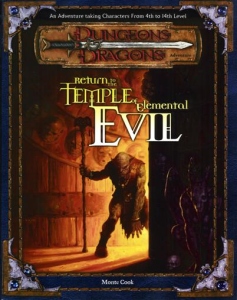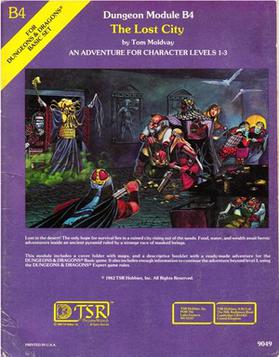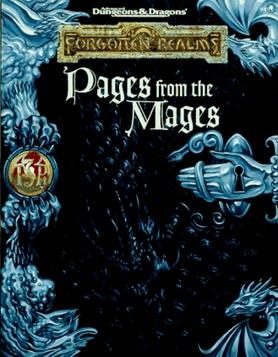
Pool of Radiance is a role-playing video game developed and published by Strategic Simulations, Inc (SSI) in 1988. It was the first adaptation of TSR's Advanced Dungeons & Dragons (AD&D) fantasy role-playing game for home computers, becoming the first episode in a four-part series of D&D computer adventure games. The other games in the "Gold Box" series used the game engine pioneered in Pool of Radiance, as did later D&D titles such as the Neverwinter Nights online game. Pool of Radiance takes place in the Forgotten Realms fantasy setting, with the action centered in and around the port city of Phlan.

The Monster Manual is the primary bestiary sourcebook for monsters in the Dungeons & Dragons fantasy role-playing game, first published in 1977 by TSR. The Monster Manual was the first hardcover D&D book and includes monsters derived from mythology and folklore, as well as creatures created specifically for D&D. Creature descriptions include game-specific statistics, a brief description of its habits and habitats, and typically an image of the creature. Along with the Player's Handbook and Dungeon Master's Guide, the Monster Manual is one of the three "core rulebooks" in most editions of the D&D game. As such, new editions of the Monster Manual have been released for each edition of D&D. Due to the level of detail and illustration included in the 1977 release, the book was cited as a pivotal example of a new style of wargame books. Future editions would draw on various sources and act as a compendium of published monsters.

The Player's Handbook is the name given to one of the core rulebooks in every edition of the fantasy role-playing game Dungeons & Dragons (D&D). It does not contain the complete set of rules for the game, and only includes rules for use by players of the game. Additional rules, for use by Dungeon Masters (DMs), who referee the game, can be found in the Dungeon Master's Guide. Many optional rules, such as those governing extremely high-level players, and some of the more obscure spells, are found in other sources.

Ravenloft is an adventure module for the Dungeons & Dragons (D&D) fantasy role-playing game. The American game publishing company TSR, Inc. released it as a standalone adventure booklet in 1983 for use with the first edition Advanced Dungeons & Dragons game. It was written by Tracy and Laura Hickman, and includes art by Clyde Caldwell with maps by David Sutherland III. The plot of Ravenloft focuses on the villain Strahd von Zarovich, a vampire who pines for his lost love. Various story elements, including Strahd's motivation and the locations of magical weapons, are randomly determined by drawing cards. The player characters attempt to defeat Strahd and, if successful, the adventure ends.

The Forgotten Realms Campaign Setting is a role-playing game sourcebook first published by TSR in 1987 for the first edition of the fantasy role-playing game Advanced Dungeons & Dragons that describes the campaign setting of the Forgotten Realms. It contains information on characters, locations and history. Various revised and updated editions have been produced over the years.

Tiamat is a supremely strong and powerful 5-headed draconic goddess in the Dungeons & Dragons role-playing game. The name is taken from Tiamat, a goddess in ancient Mesopotamian mythology. She is the queen and mother of evil dragons and a member of the default pantheon of Dungeons & Dragons gods. Her symbol is a five-headed dragon.

Savage Species is a sourcebook for use as a supplement in the 3rd edition of the Dungeons & Dragons game, detailing the use of monstrous races as PC races.

In the Dungeons & Dragons (D&D) role-playing game, Bahamut is a powerful draconic deity, who has the same name as Bahamut from Arabic mythology.

Return to the Temple of Elemental Evil is an adventure module written by Monte Cook for the 3rd edition of the Dungeons & Dragons fantasy roleplaying game, set in the game's World of Greyhawk campaign setting. It was originally published by American game company Wizards of the Coast in 2001 as a sequel to the 1985 Advanced Dungeons & Dragons (AD&D) module, The Temple of Elemental Evil.

Monster Mythology, published by TSR in 1992, is a sourcebook about non-human deities that can be used in fantasy role-playing games using the second edition rules for Advanced Dungeons & Dragons (AD&D).

The Lost City (B4) is a Dungeons & Dragons adventure module by Tom Moldvay. It was first published by TSR in 1982 and was designed as a stand-alone adventure for use with the Dungeons & Dragons Basic Set. The working title for the module was "The Lost City of Cynidicea". Moldvay designed the module as a low-level scenario to give novice Dungeon Masters experience in fleshing out adventures such that it is only partially complete. The plot involves the player characters discovering a ruined subterranean city slowly rising out of the sands. The adventure is set inside a huge step pyramid, with the lower pyramid only sketched out and the city itself described with a list of the major areas and a map. The adventure's main villain is Zargon, a giant one-eyed monster and his minions. The entire double pyramid, not including the city, contains over 100 rooms.

Forgotten Realms Adventures is an accessory for the Forgotten Realms campaign setting for the second edition of the Advanced Dungeons & Dragons fantasy role-playing game. The book, with product code TSR 2106, was published in 1990, and was written by Jeff Grubb and Ed Greenwood, with cover art by Clyde Caldwell and interior art by Steven Fabian, Ned Dameron, Larry Elmore, Caldwell, and Jeff Easley.

Magic of Faerûn is an accessory for the fictional Forgotten Realms campaign setting for the 3rd edition of the Dungeons & Dragons fantasy role-playing game.

Pyramid of Shadows is the final part of a loosely connected three part series of adventures introducing the 4th edition Dungeons & Dragons ruleset. The adventure, written by Mike Mearls and James Wyatt, was published in 2008 by Wizards of the Coast, as a sequel to the adventures Keep on the Shadowfell and Thunderspire Labyrinth. The adventure is designed for character of levels 7-10 and the module code "H" stands for Heroic Tier. This module is set in a region of the world called the Nentir Vale, the details of which are given in the 4th edition Dungeon Master's Guide.

Pages from the Mages is an accessory for the 2nd edition of the Advanced Dungeons & Dragons fantasy role-playing game, published in 1995.

Bastion of Broken Souls is an adventure module for the 3rd edition of the Dungeons & Dragons fantasy role-playing game.

The Dungeons & Dragons Adventure Game is the name of two companion accessories to the second and third editions of the Dungeons & Dragons fantasy role-playing game. Designed as simpler, stand-alone versions of Dungeons & Dragons, they feature a simplified ruleset, but with character progression that parallels the standard game. However, for 3rd-level characters and higher, the standard Player's Handbook is still required. The first version was published in 1999 for the second edition of Advanced Dungeons & Dragons, while the second version was published in 2000 for the third edition of Dungeons & Dragons.

The Apocalypse Stone is an adventure module for the 2nd edition of the Advanced Dungeons & Dragons fantasy role-playing game. It was published in 2000.

Keep on the Shadowfell is the first official product from the 4th edition Dungeons & Dragons ("D&D") line. It is part one of a three-part series of adventures. It introduces a series of 4th edition Dungeons & Dragons settings called the Points of Light, a loosely connected and open-ended series of settings designed to allow other modules and fan-created content to be integrated seamlessly into the settings' largely unmapped fantasy world or the Dungeon Master's own custom-made setting. The adventure, written by Mike Mearls and Bruce R. Cordell, was published in 2008 by Wizards of the Coast. It is followed by the sequels Thunderspire Labyrinth and Pyramid of Shadows. The adventure is designed for characters from levels 1 to 3. Its module code, "H", stands for Heroic Tier. This module is set in a region of the world called the Nentir Vale, which is described in greater detail in the 4th edition Dungeon Master's Guide.

















